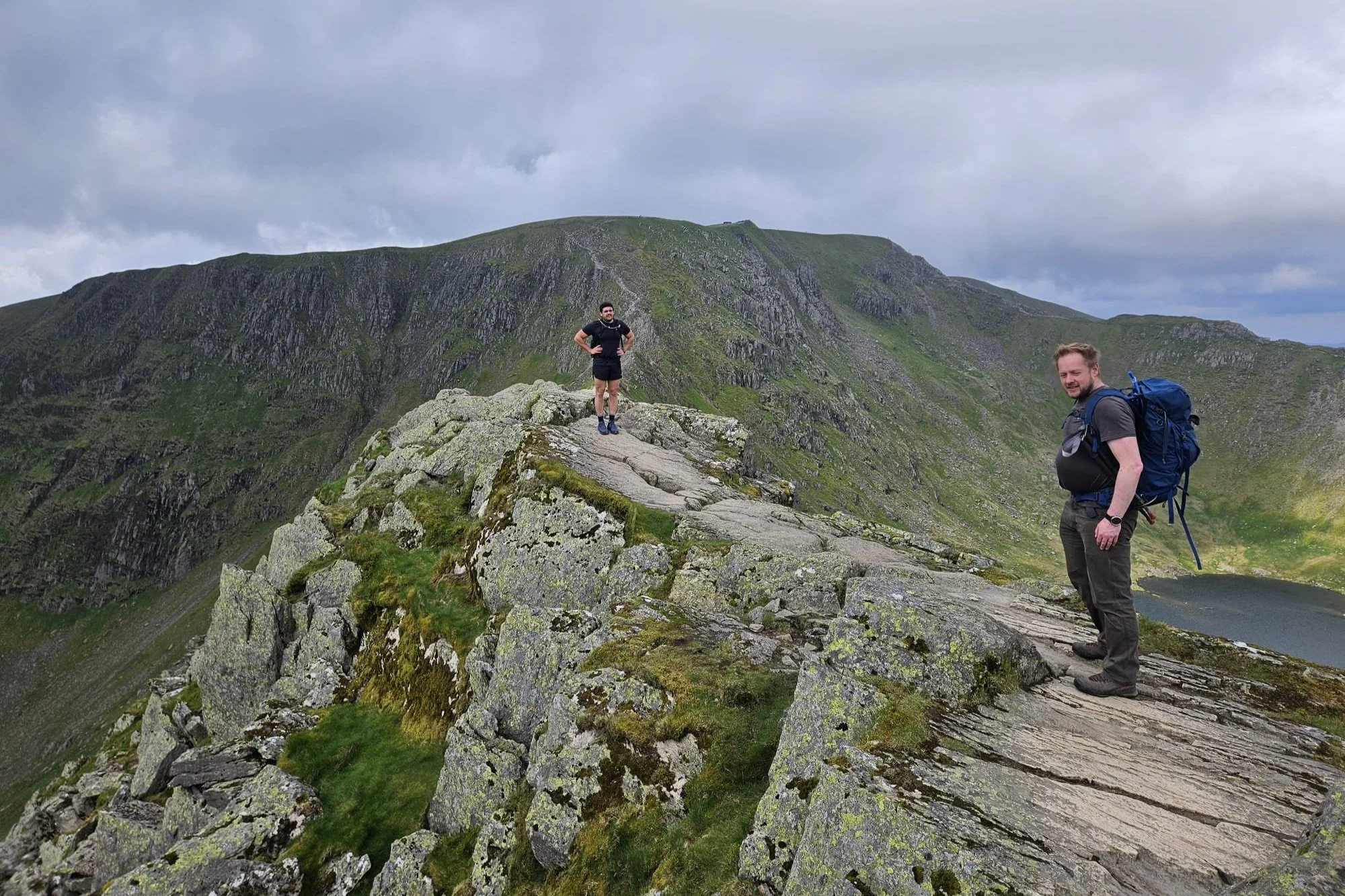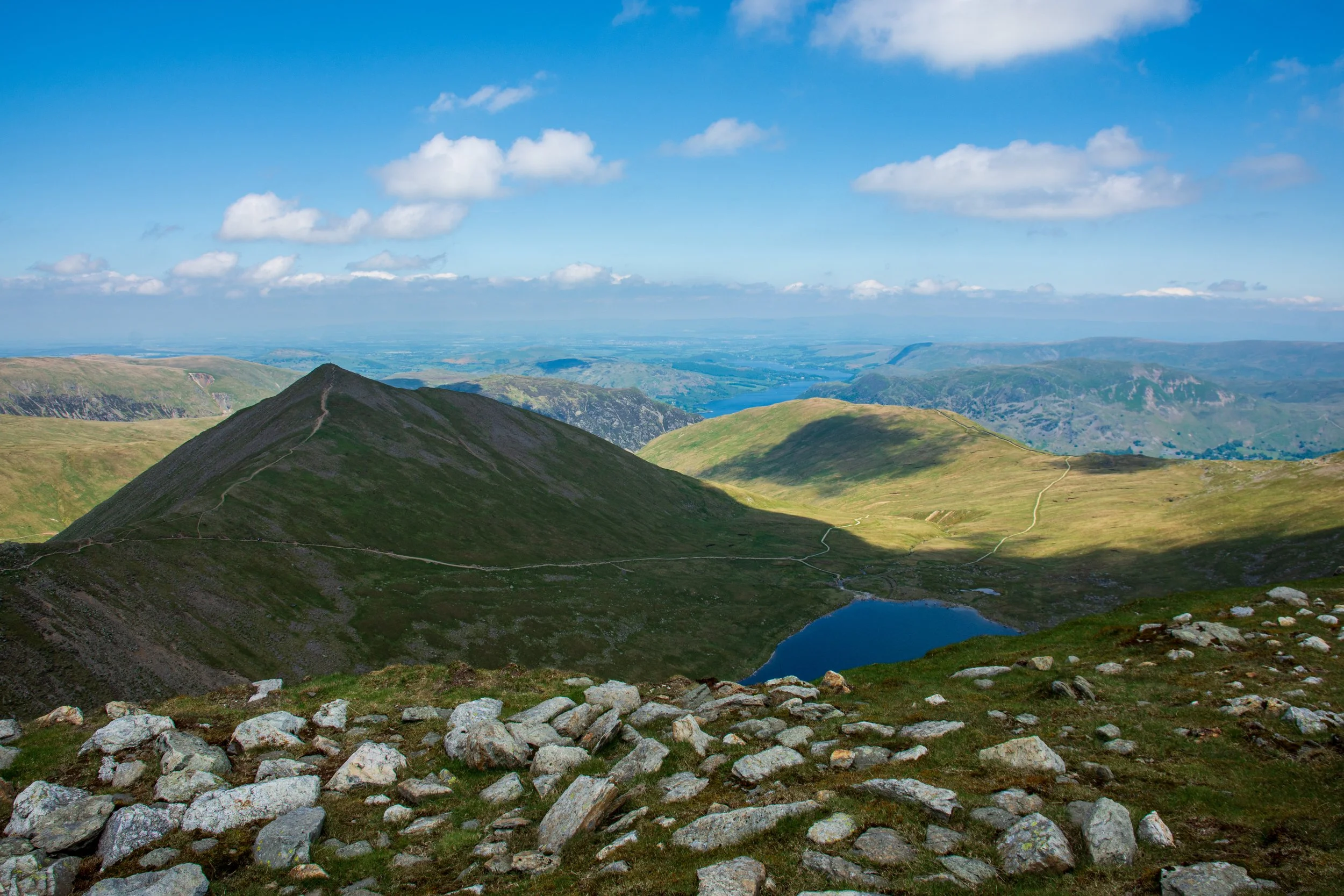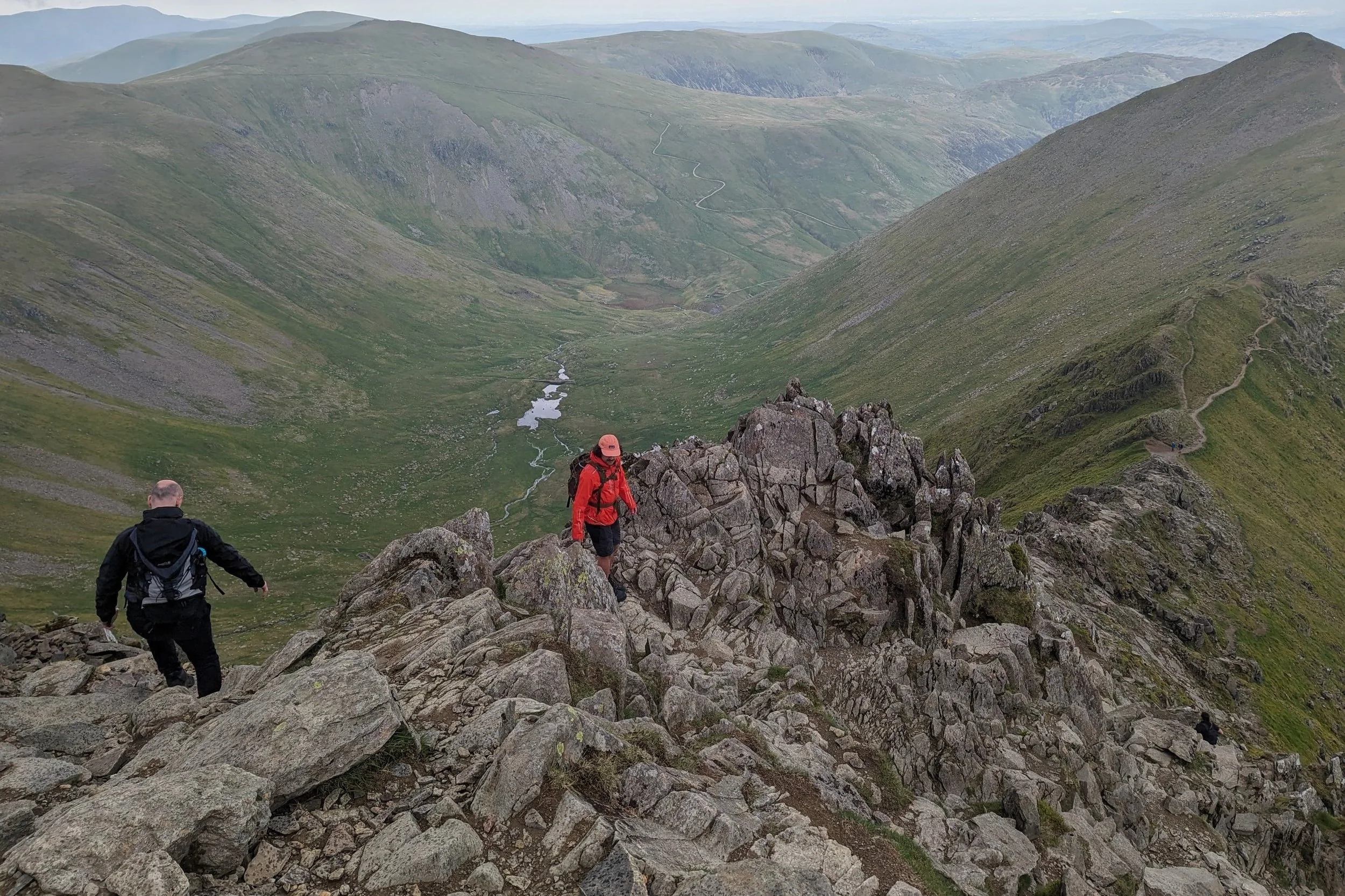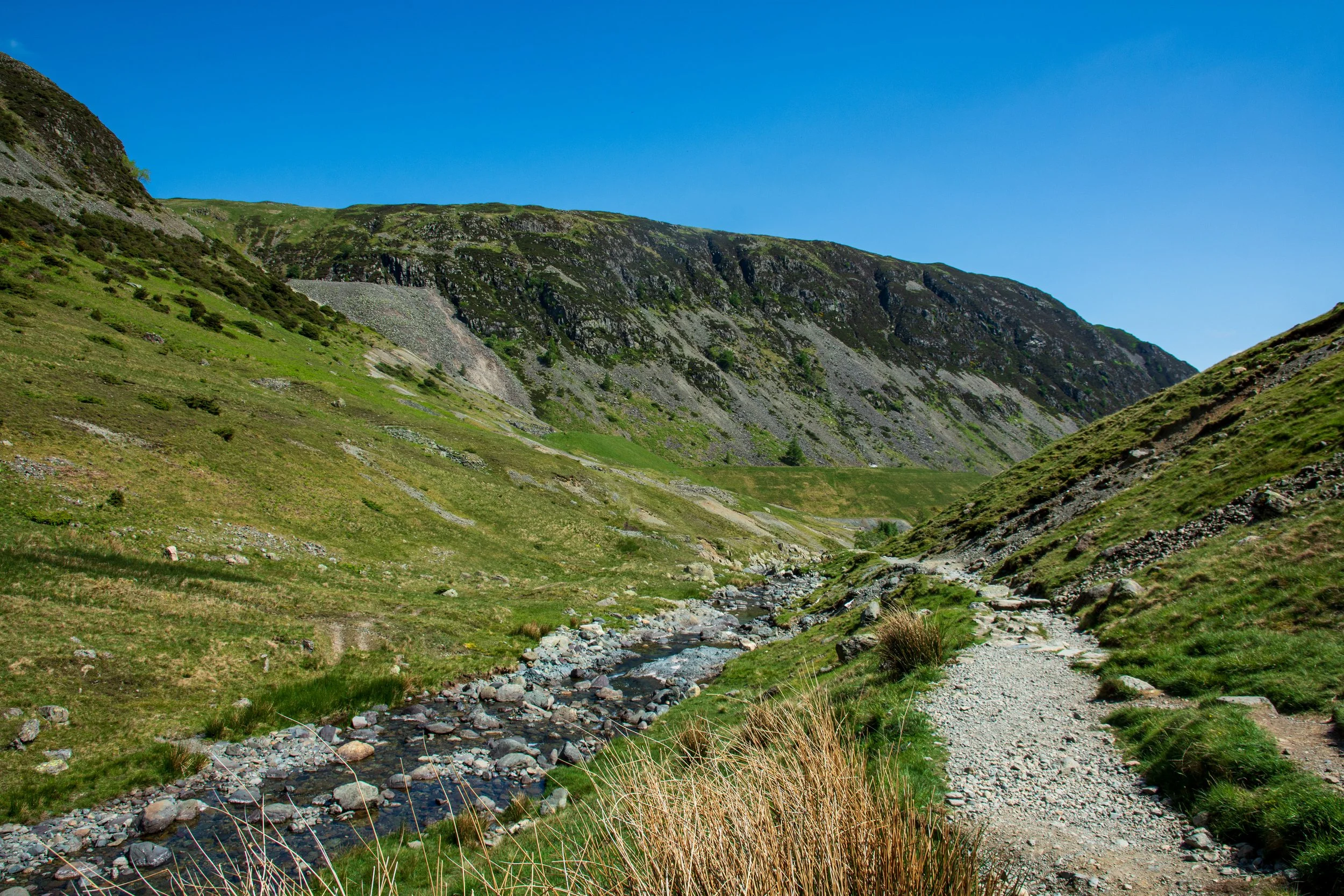Getting Ready for your Meet Your Mountain Walkshop - Striding Edge
An office with a view
This Meet Your Mountain Walkshop is a stunning day out, with stunning views and airy paths that will challenge you and test your resilience.
This epic route starts in the picturesque Lake District village of Glenridding, and ascends England’s 3rd highest mountain, Helvellyn, via the famous Striding Edge ridge, before returning via Swirral Edge.
Amongst a day of challenging hiking and a couple of ‘hands-on-rock’ moments, we will look at what personal challenges we face in our own roles in the office, share our own stories, and support each other as we take on this test together.
And then we will look at what we can take away from our experience on the day to give us the power to take on anything.
The Rotue
The walk is charecterised by 5 main parts:
1. The slow rise
Hiking up through Griesdale. Striding Edge is actually in the background, on the right.
We head out of Glenridding and cross into the neighbouring verdant valley of Griesdale. We’ll hug the side of the valley, gaining height on the path until we reach ‘The Hole in the Wall’. This part of the walk can be quite tiring as we gain height gradually, but the views are stunning.
2. The ridge scramble - Striding Edge
Me, posing on Striding Edge. This is probably one of the narrowest parts of the ridge (yet the drop to the right is still quite shallow)
We pass ‘The Hole in the Wall’ and are greeted by the sight of Striding Edge and Helvellyn in front of us. We will stop to steel ourselves for the challenge ahead. The ridge eases us in gently - a few broad and small rocky mounds to cross allow us to get a feel for the terrain, and practice our movement. The mounds start to get bigger, and the ridge narrower, but never too narrow that you feel like you’re walking on a tight rope.
The crux of the route comes at the end of the ridge - a climbdown of about 7 metres known as ‘The Chimney’, but we’ll be on hand to guide you down re-assuringly and help with your foot placement if you need it. From here, the climb to Helvellyn looks impossibly steep, but don’t be fooled, there is a path that winds up the side and allows us to walk up to the summit.
3. The Helvellyn summit plateau
A glorious view from the top. Looking at Red Tarn and Catstye Cam from Helvellyn summit. Swirral Edge is to the left, Striding Edge is out of shot to the right
Helvellyn has a large summit, and we’ll enjoy the thrill of reaching the top and the release of all the adrenaline that has built up as we’ve crossed the ridge. There are cracking views on a clear day, and we will bask in our glory (and take photos at the trig pillar to prove it!), before heading to our descent path
4. The descent ridge - Swirral Edge
The tricky start to Swirral Edge, leading off Helvellyn’s summit. There are plenty of descent options
Swirral Edge starts with a difficult-looking climb down from the summit, but it is a lot easier than it looks. There is some careful foot placement and route finding down the rocks for the first 30m or so, but after that it becomes a pleasant scramble, especially after facing Striding Edge previously. As the rocks give way to a path, there is the option of a short walking ascent up to Catstye Cam, another Wainwright, before descending into the valley below
5. The triumphant return through the valley
Following Red Tarn Beck to the valley below
We follow the beck as we descend and enter the valley above Glenridding. This is a fairly long walk back, but we will reflect on our journey and what we can take back. On returning to Glenridding, we’ll head to the pub, and commit to intentions and actions that we will take back to the office with us, from the mountain.
Is this going to be scary?
Genuinely, this is not a walk in the park, but I love this route as it eases you into a mountain scramble gradually, rather than ramping the intensity up to 11 from the start (I’m looking at you, Tryfan).
I have taken people up here, for whom (and I quote) ‘it scares the be-jesus out of me’, and who are fearful of heights, yet they faced it head on, and it never became too much. No-one I’ve led across has ever frozen on the ridge, and everyone I’ve taken has made it across.
A ridgeline that looks precarious on first glance is actually fairly wide and accommodating, and seemingly steep drops are actually a much shallower angle than they appear, with very little actual exposure.
We go for the mantra ‘crest is best’, and on this ridge - the crest is also by far the easiest and least-exposed line, but if you are really struggling, there is a bypass path that runs alongside pretty much all of Striding Edge, and even avoids the climb-down.
Swirral Edge has a hairy-looking start when you are coming down from Helvellyn, but it is not as bad as it looks, and over quickly. If we’re really struggling, there is an alternative (longer) return path that avoids Swirral Edge completely.
Looking back at Striding Edge
Route Walkthrough
What to bring
The biggest question on most people’s minds is' ‘What should I bring with me?’
I have created this video which goes through how to pack your bag for a day out in the hills
If you have been hillwalking before, it’s likely that you already have most, if not all, of the equipment required for an expedition. For ease, we have provided a list below of what we would expect you to have brought with you.
Please note that in the interests of safety, we do not take anyone out who would be put in danger, given the terrain and conditions, due to insufficient kit. If you have any questions, doubts about your kit, or are looking for recommendations, please contact us.
Your Kit List
Walking Boots
Please bring boots or shoes suitable for walking in, preferably waterproof. If you do not know which footwear would be suitable, please get in touch and we can assist. Vibram soles are good if you have them or can get them. Trainers are generally not recommended for this sort of route, but sturdy walking trainers, approach shoes or trail shoes should be okay if you are used to walking with them, and struggle with walking boots.
Walking Socks
Merino walking socks are great, but there are some good synthetic options. Thickness depends on your preference and choice of walking boot. Also pack a spare pair as well – these will be very welcome if your feet get wet
Base Layer
A number of affordable synthetic options are available, and merino wool is very good, but more expensive. Ideally thicker and long-sleeved in cold weather, thinner and short sleeved in summer. Cotton t-shirts are not recommended most of the year, but are fine in summer if dry weather is forecast.
Walking Trousers
Comfortable trousers, suitable for walking in. Technical trousers or stretchy soft-shell trousers are recommended. Please avoid non-synthetic tracksuit bottoms, jeans or cotton trousers on hill or mountain routes. Shorts can be worn, but be aware of the presence of ticks carrying Lyme Disease in summer months.
Fleece, lightweight mid-layer, and/or shower-proof primaloft jacket
One of the options above to use as an insulation layer, plus an additional layer between October and March. Note that the temperature on the hill may be lower than in the valleys.
Waterproof Jacket
This should be able to withstand showers and persistent rain. Essential regardless of forecast.
Waterproof Trousers
Should be brought if rain is forecast, optional (but desirable) if not.
Hat and gloves
Please bring a hat and gloves. Even in summer, the weather can close in quickly, and summits can be chilly.
Rucksack
Sufficient size to carry your kit - 10-20L is usually sufficient. Pack a couple of plastic bags or stuff sacks to keep wet things separate, and dry things dry.
Water
Please carry a minimum of 2 litres of water in total. There are no refill points on the route.
Sun hat and sun cream
There is no shelter at all on the route, so both are essential if any sun is forecast.
Hill food
Please bring lunch and snacks for the day. High-energy snacks are best.
Torch/headtorch
Please bring a small torch if advised – we are not likely to need it, but we never know what may happen on the day.
Personal Medication
Please bring any medication you require. If you have been prescribed an inhaler or Epipen, it is VITAL that you bring them.
Walking Poles
Optional, may be helpful in the valley sections on the route, not to be used on the ridges
Frequently Asked Questions
How fit do you have to be?
I'd say that with a little preparation, the route is well within the capability of most people.
The challenge is not a race, and we do have regular points where we stop.
Once we have passed the Hole in the Wall and are on the ridge line, we have done most of the ascent, except for the final push to the summit.
If you've done any hill walking, this is absolutely achievable for you.
Can I bring my dog?
Not for this one I’m afraid, as you will need to focus all your attention on moving over the ridge, so the last thing you want is to be doing is focussing your dog’s attention away from the sheep.
Where does it start?
The walk starts at the centre of Glenridding, in the main car park. Parking is usually £8.50 per day, and there are options to pay by card.
How long will it take?
Including the points where we will stop for the ‘workshop’ elements, the route will take approximately 6 - 6 1/2 hours, with an additional 1 1/2 hours in the pub at the end. To put into context, this is a fairly leisurely pace. We recommend setting aside 8 hours for the whole day (plus travel time)
What time do we start?
The start time can vary, so please check the details of your booked event. We always request that we meet 15 minutes prior to setting off. We can vary the start time in summer, but in Autumn and Spring we usually need to make use of the available decent daylight, which can mean a fairly early start (0630-0700).
'Decent... Daylight'? What happens if we get delayed and it gets dark?
Coming back in the dark is unlikely, but not an issue. We know the route well, and are also experienced of walking and navigating in the dark.
How busy will the route be?
The route gets very busy on Saturdays in summer, but less so during the week. It is noticably quieter on weekdays in the fringe seasons.
Do I need special equipment?
Check out the equipment list and video above, but in brief, you'll need some comfy walking boots, waterproofs, non-cotton/denim trousers and an insulation layer. You'll also need to pack a rucksack with enough food and water for the day.
Can I stay locally?
There are a number of hotels and B&Bs in and around Glenridding, plus a campsite and holiday park called Gillside. There are also several self-catering/AirBnB-style locations
What about after the challenge?
We will usually head to the Glenridding Hotel afterwards, which has ample space inside and out for a debrief, and for setting actions and intentions.
Are there refreshments and toilets on the route?
No - the only facilities are in Glenridding. Once we are on the route, we are in a ‘wild-wee’ situation.
Hang on, what about…?
If you have any other questions please feel free to contact us.







